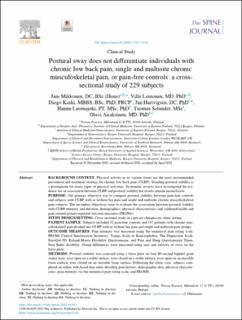Bitte benutzen Sie diese Kennung, um auf die Ressource zu verweisen:
https://doi.org/10.21256/zhaw-24937| Publikationstyp: | Beitrag in wissenschaftlicher Zeitschrift |
| Art der Begutachtung: | Peer review (Publikation) |
| Titel: | Postural sway does not differentiate individuals with chronic low back pain, single and multisite chronic musculoskeletal pain, or pain free controls : a cross-sectional study of 229 subjects |
| Autor/-in: | Mikkonen, Jani Leinonen, Ville Kaski, Diego Hartvigsen, Jan Luomajoki, Hannu Selander, Tuomas Airaksinen, Olavi |
| et. al: | No |
| DOI: | 10.1016/j.spinee.2022.04.013 10.21256/zhaw-24937 |
| Erschienen in: | The Spine Journal |
| Band(Heft): | 22 |
| Heft: | 9 |
| Seite(n): | 1523 |
| Seiten bis: | 1534 |
| Erscheinungsdatum: | 30-Apr-2022 |
| Verlag / Hrsg. Institution: | Elsevier |
| ISSN: | 1529-9430 1878-1632 |
| Sprache: | Englisch |
| Schlagwörter: | Chronic low back pain; Central sensitization; Chronic musculoskeletal pain; Demographics; Kinesiophobia; Pain duration; Pain intensity; Physical characteristics; Postural control; Postural stability |
| Fachgebiet (DDC): | 615.82: Physiotherapie 617.5: Orthopädische Chirurgie |
| Zusammenfassung: | Background Context: Physical activity in its various forms are the most recommended prevention and treatment strategy for chronic low back pain (CLBP). Standing postural stability is a prerequisite for many types of physical activities. Systematic reviews have investigated the evidence for an association between CLBP and postural stability but results remain inconclusive. Purpose: Our primary objective was to compare postural stability between pain free controls and subjects with CLBP with or without leg pain and single and multisite chronic musculoskeletal pain subjects. The secondary objectives were to evaluate the association between postural stability with CLBP intensity and duration, demographics, physical characteristics, and validated health and pain related patient-reported outcome measures (PROMs). Study Design/Setting: Cross-sectional study in private chiropractic clinic setting Patient Sample: Subjects included 42 pain free controls and 187 patients with chronic musculoskeletal pain divided into CLBP with or without leg pain and single and multisite pain groups. Outcome Measures: Pain intensity was measured using the numerical pain rating scale, and PROMs Central Sensitization Inventory, Tampa Scale of Kinesiophobia, The Depression Scale, EuroQol-5D, Roland-Morris Disability Questionnaire, and Pain and Sleep Questionnaire Three-Item Index disability. Group differences were measured using area and velocity of sway on the force plate. Methods: Postural stability was assessed using force plate on four 60 second bipedal quiet stance tests: eyes open on a stable surface, eyes closed on a stable surface, eyes open on an unstable foam surface, eyes closed on an unstable foam surface. Following the clinic visit, subjects completed an online web-based data entry detailing pain history, demographic data, physical characteristics, pain intensity via the numerical pain rating scale, and PROMS. Results: Postural sway parameters did not differ between pain free controls and subjects with CLBP with or without leg pain and single and multisite chronic musculoskeletal pain subjects. Furthermore, severity and duration of CLBP pain in addition to central sensitization, kinesiophobia, depression, quality of life, disability, and effect of pain on sleep only had very weak associations with postural stability. Conclusions: Chronic musculoskeletal pain appears not to influence bipedal postural stability. |
| URI: | https://digitalcollection.zhaw.ch/handle/11475/24937 |
| Volltext Version: | Publizierte Version |
| Lizenz (gemäss Verlagsvertrag): | CC BY 4.0: Namensnennung 4.0 International |
| Departement: | Gesundheit |
| Organisationseinheit: | Institut für Physiotherapie (IPT) |
| Enthalten in den Sammlungen: | Publikationen Gesundheit |
Dateien zu dieser Ressource:
| Datei | Beschreibung | Größe | Format | |
|---|---|---|---|---|
| 2022_Mikkonen-etal_Postural-sway-cross-sectional-study.pdf | 1.21 MB | Adobe PDF |  Öffnen/Anzeigen |
Zur Langanzeige
Mikkonen, J., Leinonen, V., Kaski, D., Hartvigsen, J., Luomajoki, H., Selander, T., & Airaksinen, O. (2022). Postural sway does not differentiate individuals with chronic low back pain, single and multisite chronic musculoskeletal pain, or pain free controls : a cross-sectional study of 229 subjects. The Spine Journal, 22(9), 1523–1534. https://doi.org/10.1016/j.spinee.2022.04.013
Mikkonen, J. et al. (2022) ‘Postural sway does not differentiate individuals with chronic low back pain, single and multisite chronic musculoskeletal pain, or pain free controls : a cross-sectional study of 229 subjects’, The Spine Journal, 22(9), pp. 1523–1534. Available at: https://doi.org/10.1016/j.spinee.2022.04.013.
J. Mikkonen et al., “Postural sway does not differentiate individuals with chronic low back pain, single and multisite chronic musculoskeletal pain, or pain free controls : a cross-sectional study of 229 subjects,” The Spine Journal, vol. 22, no. 9, pp. 1523–1534, Apr. 2022, doi: 10.1016/j.spinee.2022.04.013.
MIKKONEN, Jani, Ville LEINONEN, Diego KASKI, Jan HARTVIGSEN, Hannu LUOMAJOKI, Tuomas SELANDER und Olavi AIRAKSINEN, 2022. Postural sway does not differentiate individuals with chronic low back pain, single and multisite chronic musculoskeletal pain, or pain free controls : a cross-sectional study of 229 subjects. The Spine Journal. 30 April 2022. Bd. 22, Nr. 9, S. 1523–1534. DOI 10.1016/j.spinee.2022.04.013
Mikkonen, Jani, Ville Leinonen, Diego Kaski, Jan Hartvigsen, Hannu Luomajoki, Tuomas Selander, and Olavi Airaksinen. 2022. “Postural Sway Does Not Differentiate Individuals with Chronic Low Back Pain, Single and Multisite Chronic Musculoskeletal Pain, or Pain Free Controls : A Cross-Sectional Study of 229 Subjects.” The Spine Journal 22 (9): 1523–34. https://doi.org/10.1016/j.spinee.2022.04.013.
Mikkonen, Jani, et al. “Postural Sway Does Not Differentiate Individuals with Chronic Low Back Pain, Single and Multisite Chronic Musculoskeletal Pain, or Pain Free Controls : A Cross-Sectional Study of 229 Subjects.” The Spine Journal, vol. 22, no. 9, Apr. 2022, pp. 1523–34, https://doi.org/10.1016/j.spinee.2022.04.013.
Alle Ressourcen in diesem Repository sind urheberrechtlich geschützt, soweit nicht anderweitig angezeigt.